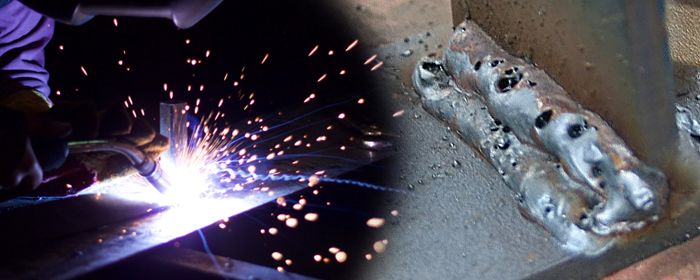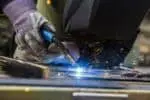MIG welding may very well be the most popular welding application in use. It is thought to be relatively easy to learn. MIG welding can be done in two ways: with gas or gasless.
While they do share some similarities, each kind of welding process has both advantages and disadvantages and here we concentrate on gasless MIG welding.

What Can I weld with my gasless MIG welder?
-
-
- Stainless Steel
- Mild Steel
- Galvanized steel
- Metal that is rusted, dirty, painted, or contains debris
- 20-gauge metal that is approximately 1/16-inch all the way to one inch in thickness
- General welding and outdoor repairs
- Agricultural Farm repairs and maintenance
- Heavier structures and structural repairs
-
The Difference Between Gas and Gasless
While both welding types use the MIG welding method, the nature of this method requires a substance to shield the weld from contamination. This is where gas and gasless welding differ.
Gas MIG welding requires a shielding gas to protect or “shield” from contamination. This gas normally is contained in a tank or gas cylinder that is fed into the welding gun together with filler wire. The gas acts as a shield to protect the weld.
Gasless MIG welding is technically impossible however it becomes possible with the use of a flux core wire that has self-shielding properties. These self-shielding properties eliminate the need for a separate gas source.
These two types of MIG welding have different capabilities including where they can be used, what type of metal they can weld, and the thickness of the metal to weld. Differences can seem to be quite complicated technically. Here we examine what you can weld with gasless MIG welding and a bit more.
Shielding Gas for Gas/Gasless MIG Welder
A gas MIG welder will use shielding gas from a separate source, usually, a tank or a cylinder, fed to the welding gun by way of a hose attached to the welding machine. When the gun operates, both the gas and wire are fed simultaneously from the gun’s nozzle to heat and melt the metal that is being welded.
The gasless MIG welding is for all purposes, technically not gasless! However, instead of making use of a gas tank or cylinder, that must be transported to furnish gas as a shield for welding, it uses flux core wire that is fed from a tubular wire spool.
Flux core wire will produce vapors, substituting gas, that will like shielding gas, protect your weld pool from contamination. A characteristic of these vapors is that they will also produce “slag”.
Slag provides even more protection from atmospheric contamination and oxidation. It must however be cleaned when the welding process is completed.
See also: Can I use MIG gas for TIG welding?
Smoke and Fume Production
One substantial difference between the two kinds of MIG welding is the production of fumes and smoke during the procedure. When utilizing gasless MIG welding, more smoke and fumes will be produced than with gas MIG welding.
These fumes are toxic and can cause damage to your health. For this reason, gasless MIG welding should be practiced outdoors or in an area that is exceptionally well-ventilated.
The “Where” in Gasless MIG Welding
One of the noteworthy advantages to doing gasless MIG welding is that the compounds contained in the flux core wire will produce vapor. For this reason, this welding procedure is much more stable and much better suited for welding that needs to be done outdoors.
It is not at risk for contamination due to windy weather conditions, and as such the quality of welds is not at risk. It is particularly indicated for structural repairs, structural construction, agricultural repairs and maintenance.
Preparation of the Base Metal
Another substantial advantage to gasless MIG welding is the preparation of the metal you wish to weld. If you are using gas MIG you will need to thoroughly clean the metal of any grime, dirt, rust, paint, etc. before welding. It must be perfectly clean in order not to compromise the weld.
With gasless MIG welding, this is not the case. Flux core wire allows you to weld metals that are rusty, painted, imperfect, or just plain dirty without a problem. This means you save considerable preparation time and if you need to do outdoor structural or agricultural repairs, you’re good to go without much fuss.
While it is always recommended that metal be cleaned before welding, gasless MIG welding does not require the metal to be perfectly cleaned of any substance to succeed.
What Can I Weld Using Gasless MIG?
While the welding process is not that different between gas or gasless MIG welding, what you can weld is. Both the types of metal and above all the thicknesses of the metals will differ. Depending on your project, gasless MIG welding can be advantageous.
A gas MIG welder that is not industrial can only weld metals up to a quarter-inch thick, and herein lies the greatest advantage of gasless MIG welding.
Since the gasless MIG welder has much greater penetration, they are more appropriate for welding metals that are substantially thicker with good results.
They are also very efficient providing good productivity results. Nonetheless, gasless MIG welders are basically used for welding steel.
1. The Wire
Gasless MIG welders will utilize a hollow flux core wire that self-shields. When the wire is melted, the vapor forms a shield around the weld to protect it from contamination.
There are different kinds and various sizes of welding wires. Depending on what you are welding, the appropriate wire will be selected. Usually, for welding thicker metals you will need a thicker wire.
2. Polarity
A gasless MIG welder will use DCEP or Direct Current Electrode Positive when operating. The torch polarity should be negative for gasless welding.
3. Position
A lot will depend on the position you need to use to weld. For some out-of-position welding, the gas MIG might be more appropriate, for example, vertical upward weld.
If you will be doing basic welding chores, a gasless MIG welder will probably be more than adequate and can be used in all positions if you have the correct filler material.
4. Cleaning Your Weld
While a gas MIG weld will be neat and not necessitate chipping or sanding, a gasless weld produces quite a bit of spatter and slag. once the metal has cooled, the metal must be cleaned.
The What and Why of Using Gasless MIG Welding
There are several factors to keep in mind when deciding to use gasless MIG welding:
1.) Thickness. A gasless welder will weld thicker metals more effectively and rapidly.
2.) Metal. Gasless MIG welders are basically used with steel.
3.) Welding Location. Gasless MIG welding is most suitable for outdoor welding, although it can be used indoors if the area is very well ventilated.
4.) Welding Skill. Gasless MIG welding is easier for beginner welders.
5.) Costs. As gasless MIG welding requires fewer supplies, for example, no gas cylinder, it is considered less expensive overall because it has a high productivity rate.
6.) Appearance. One of the drawbacks of gasless MIG welding is that you are going to have to clean up splatter and slag at the end of the weld.
7.) Portability. A gasless MIG welder does not require an outside gas source such as a cylinder, making it lighter weight and more portable than other types of welders.
8.) What. Gasless MIG welding is top-notch for manufacturing necessities and repairs.
The Advantages of Gasless MIG Welding
Fundamentally the advantages of gasless MIG welding include:
1.) Convenience. It weighs less making it more portable. It also won’t be necessary to clean the surfaces because gasless MIG permits you to weld through galvanized, painted, or even rusted surfaces.
2.) Outdoor Welding. You can weld in bad or extreme weather conditions with no need for a gas cylinder. Windy weather conditions will affect a MIG weld with shielding gas adversely, compromising a weld. Gasless MIG welding avoids this problem all together thanks to its stability.
3.) Material. A gasless MIG welder will provide exceptional penetration and strength and are capable of welding considerably thicker metals than a gas welder.
4.) Position. Much will depend on the position you intend to use for the weld. A gasless MIG welder can be used in all positions if you have the correct filler material.
5.) Gasless MIG welding has high productivity and rate of deposition.
A Final Thought
While each type of welding application offers advantages and disadvantages, gasless MIG welding is the best choice for welding thicker metals and metals that are not perfectly clean of grime, debris, rust, or paint.
It is not ideal for welding thin metals, aluminum, or automotive bodywork due to its penetration. They do, however, produce high-quality strong welds that are needed in repairs, agriculture, structural work, and manufacturing.






